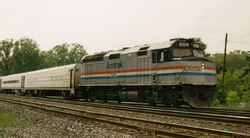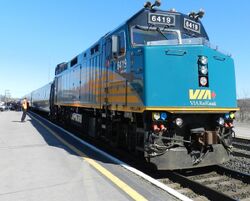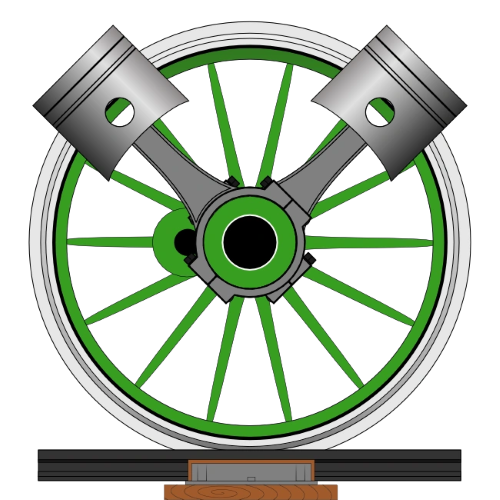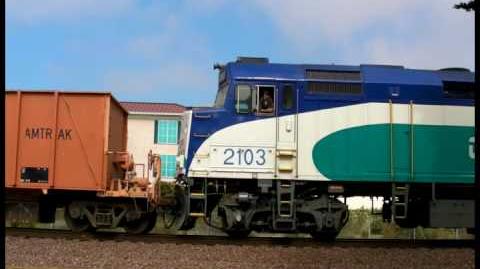
Amtrak #345 in "Phase III" Livery

Via Rail Canada #6419
The EMD F40PH is a full cowl-bodied, 3,000 hp to 3,200 hp four-axle diesel-electric locomotive, which was originally built by Electro-Motive Division between 1975 to 1992 and was then built by Morrison-Knudsen Rail and then MPI (Motive Power Inc) in the 1990s and early 2000s. Amtrak's F40PHs began to be replaced by the GE P32-8BWH in 1991, and later, the GE Genesis series locomotives in 1993. The last F40PH made its final revenue run for Amtrak on June 1, 2002.
Many still exist, in service on various commuter railroads. For Amtrak, only their NPCU (Non-Powered Control Unit) conversions remain on the roster, with several other F40PHs stored on Amtrak property as of recently.
The NPCU conversions included the removal and gutting of the prime mover and generator, traction motors and main running gear, in favor for luggage/baggage space.
The GE Genesis series locomotives (aside from the EMD F59PHI for commuter service) served as its official replacement for revenue passenger service, though these are slowly being replaced by the new Siemens ALC-42 Charger Locomotives.
History[]
In 1971, after Amtrak was formed, it initially inherited a fleet of dated first generation E and F-units from the predecessor railroads it took passenger service over from, with much of it in dire need of replacement. Two types of locomotives were immediately recognized; One of them a six-axle unit equipped with large fuel tanks and water reserves, to be used for long-distance journeys. The other one, a smaller, lighter, and faster unit, equipped with HEP (Head-End Power), and meant for service on Corridor routes in the Midwest and the Northeast.
Of the two types, the first was considered a priority. EMD won the contract to supply what would eventually be 150 units of what would be called the SDP40F. They were then delivered in 1974.
The second type, the EMD F40PH, first entered service in 1975, initially on the short distance and regional train services.
Shortly after the SDP40Fs were delivered, there were a number of derailments on trains pulled by those locomotives. These trains were subsequently forced to slow down in curves, throwing long-distance schedules out the window. The causes were later traced to the lightweight baggage cars, which caused vibrations when placed behind the much heavier SDP40F locomotives. For this reason, as well as the adoption of HEP as the standard for passenger train heating and lighting, ultimately caused Amtrak to rapidly phase out the SDP40F, and quickly adopt the F40PH as the standard diesel locomotive for both regional and long-distance service.
Amtrak wasn't the only rail company to see use of the locomotive; many commuter railroads, namely Metra, have selected it in order to modernize its fleet. All except GO still operate the F40PH. VIA Rail Canada bought 59 of these locomotives when they, too, adopted HEP as the standard for lighting and heating.
Many units were built, and most are still in service, either in their original versions or in rebuilt form. Amtrak rebuilt several into non-powered "Cabbage" cars (Control cab/baggage car, or NPCU), when their fleet of F40PHs were replaced by the more powerful and crash-resistant GE Genesis in the late 1990s. NPCUs can be identified from the standard F40PH by the lack of grills and rooftop cooling fans as the baggage area has now replaced the standard engine room. NPCUs are commonly seen on Amtrak's "Downeaster" leading southbound trains, and are also seen on Amtrak's "Pere Marquette", "Wolverine", "Blue Water", "Cascades", "Pacific Surfliner", and "San Joaquin". Those NPCUs that operate on Cascades unlike the rest of the NPCUs, do not have a baggage area because the Talgo trains have their own dedicated baggage compartment. They do have a concrete weight to meet FRA standards because the "Cascades" train sets do not meet this requirement.
As of 2003, no F40PHs operate on Amtrak anymore. Some unaltered F40PHs remain unused, stored on Amtrak railroad property. F40PH 406 was removed from storage in 2011 after being dormant for almost 10 years. It was converted into an NPCU and was equipped with an HEP generator to provide power to the 40th Anniversary Exhibit Train. Unlike many NPCUs on Amtrak, this unit retains its original road number and Phase-III livery. It also resembles an F40PH externally, such as the rooftop fans on top of the locomotive.
abput a handful of F40PHs remain stored on Amtrak property. These units remain as true F40PHs that were never converted to NPCUs. None remain in service and most other F40s owned by Amtrak have either been sold to other railroads, donated to railroad museums, or scrapped. The fate of the stored F40s is uncertain, or is it?
there is hope, as In the mid-2000's, F40PH #281 was privately sold to the California State Railroad Museum and remains there to this day still bearing its well-faded Amtrak Phase III Livery. It also still operates on museum events.
In 2004, Amtrak F40PH #307 was purchased for exactly $1.00 by the North Carolina Transportation Museum Foundation for preservation. also wearing its Phase III livery albeit being very rough. There are recent rumors that it will be fully restored for either display or operational museum use.
GO Transit[]
Following the success of GO's Lakeshore lines, GO set out on a mission to further expand its network. One of their plans was to purchase new locomotives, and following the success of GO's existing GP40-derived passenger locomotives, GO ordered six F40PH units from GM of London, Ont. They were the first F40PHs built in Canada.
GO's F40PHs were not seen as the most successful locomotives in their fleet; the parasitic HEP system, unlike the GP40TC's separate system, reduced the power available to pull the train. While the F40PH may have fared better for Amtrak's shorter regionals, they were definitely not the best units for pulling 10 Hawker Siddely BiLevel cars fully loaded with commuters. The engine, which has to run at full power all the time, also proved unpopular with both crews and the residents near Willowbrook; the locomotive was not fuel efficient, and Willowbrook residents were not getting any sleep from the noise. Because of this, they were nicknamed "howlers". All were retired by 1988, being replaced by the first F59PH order. All of them were sold to Amtrak.
It should be noted that unlike the later VIA locomotives, these were similar in every aspect to the Amtrak units, with the exception of the passenger-style pilot and the lack of a dynamic brake section.
Specifications[]
- Length Coupled: 56ft 2 inches
- Width Max: 10ft 7 inches
- Height Max: 15ft 7.5 inches
- Engine: EMD 16-645E3
- Trucks: EMD Blomberg
- Trac Power: 3000~3200hp Max, 2400hp in HEP Mode
- HEP Power: 500kW driven by Main Diesel, 800kW driven by a separate Diesel
- Max Speed: 110 MPH/177 KPH
Versions[]
- F40PHR - F40PHs built from parts reused from traded-in SDP40F locomotives. They are also rated 3,200 hp.
- F40PHM-2 - The commuter railroad Metra's version of the F40PH. Sports a sloped cab similar to the EMD F69PHAC. The last type of locomotive to be turned out of La Grange in 1993.
- F40PH-2 - An upgraded version of the F40PH with 3,200 hp and upgraded electrical systems. Caltrain and Metra use this variant as their standard locomotives.
- F40PH-2CAT - New Jersey Transit (NJ Transit)'s version of the F40PH with a separate HEP generator engine (as opposed to shaft driven on previous F40PHs); rebuilt from MPI (MotivePower Industries). Most Caltrain F40PH-2 locomotives were also rebuilt into this variant.
- F40PH-2C - Massachusetts Bay Transit Authority (MBTA)'s version of the F40PH with "wind-breaker" covers and separate HEP generator on a stretched frame; 1050-1075 EMD built. 1025-1036 were built by MK Boise and classed as F40PHM-2C. Caltrain also owns three of these, easily identified by their lack of a headlight in the nose and extended length compared to Caltrain's standard F40PH-2 locomotives. All but one locomotive in the Altamont Corridor Express (ACE) fleet is also of this type.
- F40PHL-2 - Modified cab version of the F40PH built for Tri-Rail, and rebuilt by MPI. All retired in 2015. 2 were sold to Durango & Silverton Narrow-Gauge Railroad and rebuilt to MP2000NGs, but have not entered service as of 2023 due to a lawsuit between the D&SNG and the now-defunct MP&ES, the latter of whom ultimately filed for Chapter 7 bankruptcy on February 25, 2022.
- F40PH-2D - Canadian version of the F40PH, only produced for VIA Rail Canada. Featured desktop controls and were rated 3000-3200 hp. Geared for a maximum of 90 mph, but most have since been regeared for 95 mph. Classed by CN as GPA-30a/b/c/d. Rebuilt into F40PH-3D between 2008-2012.
- F40PH-3 - Any Metra F40PH that has been rebuilt recently. Was also built new by MPI, Locomotives 115, 216, 120, 123, 109, 102, 101, 106, 103, 104 were rebuilt throughout 2021-2023 while the rest are expected to be replaced by the new EMD F125 Locomotives
- F40PH-3(C) Any MBTA F40PH that has been rebuilt recently.
- F40PH-3(D) - VIA's rebuilt F40PH locomotives. See page for more details.
- F40FH: A re-geared F40PH operated by the Grand Canyon Railway.
Operators[]
The following tables lists most operators of the F40PH both past and present.
American operators[]
| Railroad | Model | Quantity | Road numbers | Notes |
|---|---|---|---|---|
| Amtrak | EMD F40PH | 78 | 200–229; 270–279; 300–309; 332–359 | |
| EMD F40PHR | 132 | 230–269; 280–299; 310–331; 360–400; 401–409 | ||
| Caltrain | EMD F40PH-2 | 20 | 900–919 | |
| Massachusetts Bay Transportation Authority | EMD F40PH | 18 | 1000–1017 | |
| EMD F40PH-2C | 26 | 1050–1075 | 1073 destroyed in Back Bay derailment | |
| Metra | EMD F40PH-2 | 11 | 174–184 | |
| EMD F40PHM-2 | 30 | 185–214 | ||
| Metrolink | EMD F40PH | 1 | 800 | Stored, formerly used as backup unit, originally part of a cancelled overhaul program. |
| Metro North | EMD F40PH-3C | 8 | 4907-4914 | |
| Music City Star | EMD F40PH | 4 | 120-122, 381 | Ex-Amtrak |
| NJ Transit | EMD F40PH | 17 | 4113–4129 | 2 units retained, remainder sold. |
| Regional Transportation Authority | EMD F40PH | 74 | 100–173 | All to Metra |
| Speno | EMD F40PH-2M | 4 | S1–S4 | |
| Trinity Railway Express | EMD F40PH | 2 | 130-131 | Purchased from LTEX, rebuilt by Progress Rail for TRE. Originally AMTK 270 & 274 |
| Virginia Railway Express | EMD F40PH/-2 | 7 | V30-V36 | All retired |
| Altamont Commuter Express | MPI F40PH-3C | 6 | 3101–3106 | |
| Caltrain | MPI F40PH-2C | 3 | 920–922 | |
| Coaster | M-K F40PHM-2C | 5 | 2101–2105 | All retired, 2 units preserved |
| Massachusetts Bay Transportation Authority | M-K F40PHM-2C | 12 | 1025–1036 | |
| Tri-Rail | M-K F40PHL-2 | 5 | 801–805 | All overhauled 2018-2021 |
| M-K F40PH-2C | 3 | 807–809 | All overhauled 2018-2021 |
Canadian operators[]
| Railroad | Model | Quantity | Road numbers | Notes |
|---|---|---|---|---|
| Exo | EMD F40PH | 17 | 226, 243, 271, 270, 274, 287, 293, 301, 302, 310, 319, 330, 331, 372, 400, 411, 418 | Majorities sold to LTEX and other operators. |
| GO Transit | GMD F40PH | 6 | 510–515 | All sold to Amtrak |
| Ontario Northland | EMD F40PH [1] | 2 | 220-221 | Converted to NPCUs |
| Tshiuetin Rail Transportation | EMD F40PH?[2] | 2? | 600-601? | |
| VIA Rail | GMD F40PH-2 | 59 | 6400–6458 | All rebuilt by 2013. |
Trivia[]
- The F40PH was one of the first EMD passenger locomotives to use the 645-series prime mover, and was one of the first production EMD unit to utilize Head End Power (HEP).
- Metra operates only F40PH's on several lines.
- Early F40PH units were delivered in the railroad's "Phase II" scheme.
- Via Rail in Canada still uses their F40PH's in regular service.
- The majority of surviving Amtrak F40PH NPCU locomotives have unique "attic" storage compartments where the original radiators were.
- NPCU's are popularly nicknamed "cabbage" cars because they are baggage cars with cabs.
- Amtrak F40PH 406 was rebuilt with a HEP generator for the exhibit train and it's original number was reactivated in Amtrak's roster.
- NPCU's don't have HEP and they're numbered in the "90" prefix series (except 406).
- Amtrak originally owned 8 original F40PHs as of 2017. The units were 401-405, and 407-409. However, as of May 5, 2021, those locomotives have been sold.
- The CAT Marine Power prime movers are proven to rate up to 480 horse power instead of the usual 3000 horse-power that the original 645-series prime mover has.
- There are 22 NPCUs numbered 90200, 90208, 90224, 90225, 90229, 90230, 90278, 90340, 90368, and 90413.
- Amtrak F40PHs 262 and 312 were wrecked at the Big Bayou Canot on September 22, 1993.
- Amtrak F40PHs 272 and 366 were wrecked in an accident at Back Bay, Massachusetts on December 12, 1990.
- Amtrak F40PH 213 was involved in an accident on the Coastliner.
- When Amtrak 406 was originally built in 1988, it originally had a center marker light above the cab, and it got replaced with a center ditch light when it was overhauled in 2000, but when it was rebuilt with the CAT prime mover in 2011, the center ditch light was removed and the center marker light was reinstalled.
- Two Amtrak F40PHs #375 and 258 run on Metra. They were removed from storage in 2009 and rebuilt into F40PH-3s before entering Metra service. They are numbered #215 and #216 on Metra.
- Another Ex-Amtrak F40PH came to Metra. METX #217 first went to Virginia Railway Express after Retirement from Amtrak and was renumbered #V-32. After the lease Expired, it was soon sold to Metra but didn't see service until 2016 after rebuild and acquisition to Metra.
- 90368 was the first NPCU built for Amtrak and the last to retain the Phase III paint scheme.
- 90413 was the last NPCU built for Amtrak.
- 90229 was the last NPCU in Phase 4 paint, but was overhauled and repainted in Phase 5 paint in May 2014.
- 90229 was also the only NPCU to be equipped with a Nathan Airchime P5A horn, but during overhaul it was re-equipped with a K5LA.
- 90221 was the first NPCU in Phase 5 paint.
- The NPCU units aren't powered, but Amtrak still classifies them as true diesel locomotives because they are also maintained at locomotive shops and they still have their drive wheels.
- CNRY (Cincinnati Railway) #381 is a former Amtrak Surfliner (from Amtrak California) F40PH unit which still retains its original scheme. Although no longer owned by the company, it now currently resides serving the Nashville Star commuter railroad and was repainted in 2020, but retains its original number.
- CSX operates a fleet of former Amtrak F40PH units as part of their "business fleet", to which they commonly haul business or track inspection trains. (Aside from special excursions.) These units actually replaced their F-units which originated from their predecessor's heritage. Sometime in 2021, 3 of these locomotives were repainted into a paint scheme mirroring that of CSX predecessor Baltimore & Ohio Railroad.
- Several shortline railroads own F40PH units, and often use them for freight operations as a heavy-duty cowl unit.
- The majority of shortlines which own F40PH units for freight and passenger service are actually from Amtrak's heritage.
- Such shortlines as the Grand Canyon Railway own F40PH units for dual service (freight and passenger), yet often serve as spare units for as a temporary replacement if their historic steam locomotives and early diesel locomotives aren't operational for any of their usual excursions.
- Amtrak F40PH units 401, 402, 404, 408, and 409 are believed to be still sitting in storage at Bear, Delaware as of February 2013. A rumor has been stated mentioning that these particular units will be rebuilt with CAT Marine Power prime movers at Beech Grove, Indiana and will return to service, but no statement has been made for their intended use.
- Amtrak F40PHs 403, 405, and 407 are currently being rebuilt with CAT Marine Power prime movers at Beech Grove, IN as of September 26, 2012 and will return to service (according to Eastern Railroad News). This has not been proven, however. As of July 2021, these units have since been sold.
- Amtrak No.'s 90224, 90278, and 90413 are the only 3 NPCU's that are equipped with Graham-White 373 Electronic Bells.
- However, after its was overhauled, 90224 was given a steel bell instead of an e-bell.
- Amtrak NPCU 406 is equipped with a generator for Head-End Power. This generator allows it to move on its own, but only at a maximum of 4 miles per hour.
- 90230, [[1]], and 90340 were built without baggage doors, yet are used as cab cars. Instead, they have a concrete weight for FRA reasons.
- This is because the Cascades Talgo trains already have dedicated baggage compartments.
- 90219, 90222, and 90368 were the last 3 NPCU's in Phase III paint, but 90219 and 90222 are both in the process of becoming overhauled and repainted in Phase V paint at Beech Grove, IN.
- 90368 returned to service in early 2013; this unit still wore its Phase III scheme until 2016, when it went into overhaul again and returned to service in 2017 with Phase V Paint which means no more NPCUs (except 406) wear Phase III Paint.
- Some NPCUs overhauled now feature red marker lights on the back of the unit (as well as the reverse lights they always had after conversion).
- By contrast, those NPCUs not overhauled lack the red marker lights; they only have the reverse light as if the NPCU was moving backwards.
- 90215, 90218, and 90225 were overhauled and repainted in the "1985 vintage Caltrain colors Amtrak California" paint at Beech Grove, IN. (90218 was finished in March 2013, 90225 was finished in June 2013, and 90215 was finished in October 2013) when they were leased to CalTrans.
- GO Transit was the only railroad who did not consider the F40PH to be a success in their fleet. As they had their HEP driven directly by the engine, they were underpowered.
- Amtrak NPCUs 90208 and 90221 are now Veterans Units, similar to P42DC No. 42 and ACS-64 No. 642.
- Amtrak NPCU 90250 now wears a scheme promoting the Seattle Seahawks NFL team.
- In late 2016 through mid 2017, NPCU #406 was wrapped into a Ski Service Scheme for Ski Service in Denver.
Popular Culture[]
- Amtrak F40PH 251 can be seen in Reading Rainbow.
Pics[]
Vids[]
Refs[]
- http://thedieselshop.us/Data%20EMD%20F40PH.HTML
- http://wikivisually.com/wiki/EMD_F40PH
- Locomotive Truck EMD#BlombergB\M


